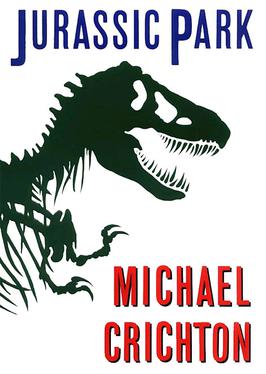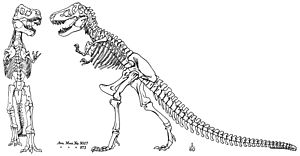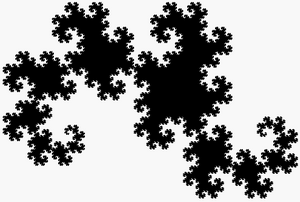Jurassic Park (novel) facts for kids

First edition cover
|
|
| Author | Michael Crichton |
|---|---|
| Cover artist | Chip Kidd |
| Country | United States |
| Language | English |
| Genre | Science fiction novel |
| Publisher | Alfred A. Knopf |
|
Publication date
|
November 20, 1990 |
| Media type | Print (Hardcover and Paperback) |
| Pages | 448 |
| ISBN | 0-394-58816-9 |
| OCLC | 22511027 |
| 813/.54 20 | |
| LC Class | PS3553.R48 J87 1990 |
| Followed by | The Lost World |
Jurassic Park is a thrilling science fiction novel written by Michael Crichton. It was first published in 1990. The book tells a warning story about genetic engineering. It shows what happens when an amusement park filled with dinosaurs, brought back to life through science, goes terribly wrong. The story also explores chaos theory, which is about how small changes can lead to big, unpredictable results.
A sequel to the novel, called The Lost World, came out in 1995. Both books were later published together in 1997 as Michael Crichton's Jurassic World.
In 1993, famous director Steven Spielberg turned the book into the hit movie Jurassic Park. He also made a movie based on the sequel, The Lost World, in 1997. A third movie, Jurassic Park III (2001), used some ideas and scenes from both books that weren't in the first two films.
The idea for the novel started in 1983 as a movie script. Michael Crichton thought about why someone would create a dinosaur. He decided it would be for entertainment, leading to the idea of a park with extinct animals. The story was first told from a child's view, but Crichton changed it to an adult's view after feedback.
Contents
Plot Summary
Mysterious Attacks and a Secret Park
The story begins in 1989 with strange animal attacks in Costa Rica. A worker is badly hurt on a secret building project on Isla Nublar, a nearby island. One of the attacking animals is identified as a Procompsognathus.
Paleontologist Alan Grant and his student, Ellie Sattler, are asked to check this. Soon after, they are invited by a rich man named List of Jurassic Park characters#John Hammond. Hammond is the head of a company called InGen. He wants them to visit a "biological preserve" he built on Isla Nublar.
This preserve turns out to be Jurassic Park, a theme park filled with cloned dinosaurs! The dinosaurs were brought back to life using old DNA found in mosquitoes and ticks preserved in amber. Any missing parts of the dinosaur DNA were filled in with DNA from other reptiles, birds, or amphibians. To stop the dinosaurs from breeding, all the animals in the park are female and cannot have babies. They also need a special nutrient called lysine to survive.
Park Problems and a Dire Warning
Recent problems in the park have made Hammond's investors worried. To calm them, Hammond brings Grant and Sattler as new advisors. They join a famous mathematician, Ian Malcolm, who studies chaos theory. Also present is Donald Gennaro, a lawyer for the investors. Malcolm and Gennaro are very doubtful about the park's future.
Malcolm had warned Hammond before the park was built. He strongly believes the park will fail. He says it's a simple idea forced onto a very complex system with too many things that can go wrong. Hammond also brings his grandchildren, Tim and Lex Murphy, along for the tour.
The park's staff includes engineer John Arnold, scientist Henry Wu, game warden Robert Muldoon, and veterinarian Gerry Harding. During the tour, Grant finds a Velociraptor eggshell. This proves Malcolm's earlier warning that the dinosaurs are somehow breeding, even though they were designed not to.
Sabotage and Chaos
Meanwhile, Dennis Nedry, the park's main computer programmer, is unhappy. He plans to steal dinosaur embryos for a rival company called Biosyn. Nedry uses a secret code he built into the park's computer system. He shuts down the security fences and steals frozen embryos from 15 dinosaur species.
But during his escape, a sudden tropical storm hits. Nedry gets lost and is killed by a Dilophosaurus. Without Nedry to turn the security back on, the electric fences stay off. All the dinosaurs escape! The adult Tyrannosaurus attacks the tour group. A young T. rex kills the public relations manager, Ed Regis. Grant and the children get lost in the park. Malcolm is badly hurt but is found by Gennaro and Muldoon. He spends the rest of the story trying to help the others understand their danger and survive.
Struggling for Survival
The park staff manage to get the computer system working again by restarting the power. But they don't realize the system is running on backup power. This power soon runs out, shutting the park down a second time. The smart and dangerous Velociraptors escape their cage. They kill Arnold and Wu.
Meanwhile, Grant and the children slowly make their way back to the Visitor Center. They raft down the jungle river. They bring important news: several young raptors were on the island's supply ship when it left for the mainland! After they return, they are contacted by the others. Grant is told to turn on the park's main generators. Tim manages to reactivate the park's power. This allows Gennaro to force the supply ship to return to the island.
Grant, Sattler, Muldoon, and Gennaro find the wild raptor nests. They compare the hatched eggs with the park's dinosaur count. They realize the animals are leaving the island, trying to migrate. Meanwhile, Hammond goes for a walk, thinking about building a new, better park. He hears a T. rex roar, gets scared, and falls down a hill. He is then eaten by a group of Procompsognathus.
Grant figures out that using frog DNA to fill gaps in the dinosaurs' genetic code allowed some of the female dinosaurs to change into males. This meant they could breed! The park's computer system didn't count the newborn dinosaurs because it was programmed to stop counting once it reached the "correct" number of animals.
Aftermath
The survivors are rescued by the Costa Rican Air Force. The Air Force declares the island dangerous and burns it with napalm. The survivors are held by the United States and Costa Rican governments at a hotel for a long time. Weeks later, Grant is visited by Dr. Martin Guitierrez. He tells Grant that an unknown group of animals has been moving through the Costa Rican jungle. They are eating crops and chickens that are rich in lysine. This suggests that some dinosaurs might still be alive in the wild.
Prehistoric Animals Featured In Novel
- Tyrannosaurus
- Velociraptor
- Apatosaurus (Camarasaurus in some editions)
- Stegosaurus
- Triceratops
- Procompsognathus
- Dilophosaurus
- Hadrosaurus
- Maiasaura
- Cearadactylus
- Othnielia
- Microceratops (Callovosaurus in some editions)
- Euoplocephalus
- Styracosaurus
- Dryosaurus
Themes in the Story

Jurassic Park warns us about the possible dangers of science. The character Ian Malcolm often points out that creating dinosaurs is wrong. He reminds John Hammond that he is trying to play God. The park becomes a "hell" because Hammond tried to do something that should not be done.
Michael Crichton's novel is like Mary Shelley's 1818 book Frankenstein; or, The Modern Prometheus. Both stories show what happens when humans create things without fully understanding the consequences. In Jurassic Park, Henry Wu cannot even name the creatures he creates. This is similar to Victor Frankenstein, who doesn't know what to call his flawed creation. Both stories show that these actions can lead to destruction.
Like his other books, Michael Crichton's novel shows that science and technology can be both helpful and dangerous. The book highlights the pride of the scientists who inspired John Hammond to bring dinosaurs back to life. They treated the dinosaurs like products, which led to disaster. The fears about genetic engineering in the book are similar to the fears people had about atomic power during the Cold War.
|
See also
 In Spanish: Parque Jurásico (novela) para niños
In Spanish: Parque Jurásico (novela) para niños


